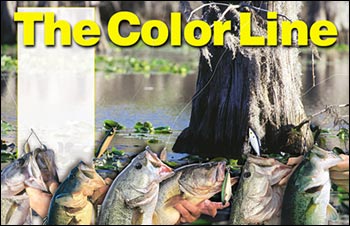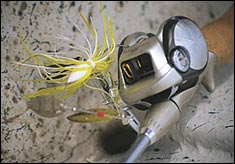
The real truth on how to go about selecting lure color
By Paul A. Cañada
After a successful day on the water, guide Brian Hughes was understandably looking forward to the next couple of days. The Dallas angler, one of the only guides experienced on Purtis Creek Reservoir, had a number of trips booked over a 4-day period. In order to save time and money, Hughes decided to camp at the state park the entire week.
During his pre-trip fishing, Hughes found the bass holding along the newly formed, inside edge of grass. The popular guide was catching fish in that transition zone, between the bank and the grass line, on a slowly fished Bass Assassin. The water was relatively clear, so Hughes was fishing a chartreuse and pepper flake version of the popular twitch bait.
"You had to place the bait up against that bank," tells Hughes, "and let it sink before working it. The key was a slow twitch and pause retrieve. The bites occurred as the bait made its way to the inside grass line."
 During the afternoon of his first scheduled trip, an April frontal system passed, dumping water on the guide and his guests. Although the downpour continued on into the evening hours, Hughes hadn't given the rain much thought. The fishing was good, so Hughes didn't expect the late season front would put the bite down. During the afternoon of his first scheduled trip, an April frontal system passed, dumping water on the guide and his guests. Although the downpour continued on into the evening hours, Hughes hadn't given the rain much thought. The fishing was good, so Hughes didn't expect the late season front would put the bite down.
The Dallas pro met his party the next morning at the ramp. After considering the slight change in water color and the cooler air temperature he thought, "This ought to be good."
As often happens, what should be isn't necessarily what will be. Indeed, the three anglers found the early going to be tough. Although the water color had just slightly changed(going from relatively clear to stained)Hughes exchanged the chartreuse twitch baits for a white and red shad version. The concerned guide encouraged his eager clients to slow down the action of their lures.
"One gentleman was having a tough time of it," shares Hughes. "He made his cast, 6 to 7 feet short of the bank, and then quickly worked the red shad twitch bait back to the boat. I was surprised when a good bass nailed his lure."
Hughes' next cast duplicated the action and location of his successful guest, however failed to draw similar results. The lucky angler's second fish forced another change. "After that second bass, we were all fishing that red shad color. We had no problem catching fish after that."
A combination of factors(location, lure action and color(keyed Hughes and his partners' angling success that day. Of the three, color seems to be the one factor that bass anglers devote the most energy and time to. Take a close look at any serious bass angler's worm collection and you're likely to see a dozen or two colors. Conversely, many of Texas' top tournament pros and guides keep the task of color selection as simple as possible.
continued
page 1 / page 2
| 




